ASUS N10JC: the Netbook Goes Corporate
by Jarred Walton on December 24, 2008 4:00 AM EST- Posted in
- Laptops
Battery Life and Power
We will start with measurements of power use with the laptop plugged into the wall. Keep in mind that some power saving features are not fully functional unless you are running on battery power, but it's still interesting to compare power requirements with other laptops under similar conditions.
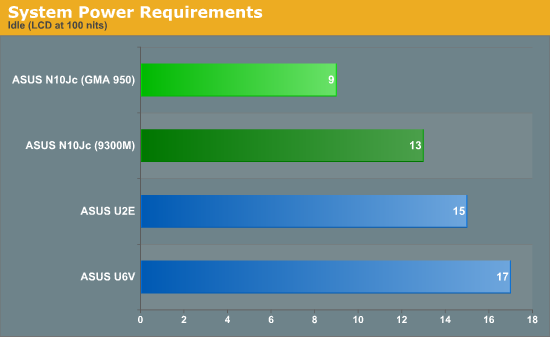
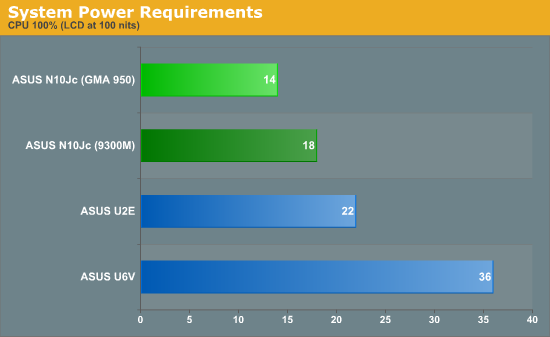
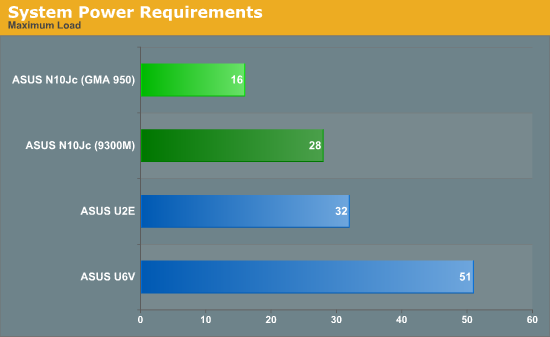
We see a significant drop in power requirements relative to the ultra low voltage Core 2 Duo U9500, especially when we disabled the 9300M. In best case scenarios, we should see almost twice the battery life for the same size battery capacity, and at worst battery life using the GMA 950 should still be 50% better. Even with the discrete graphics enabled, battery life should still be better than the U2E by a decent amount.
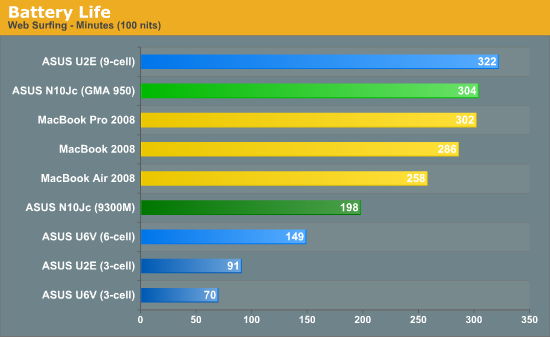
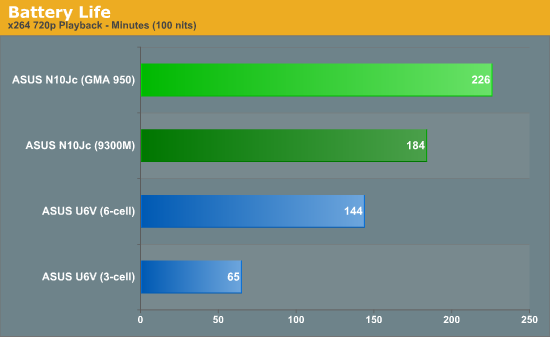

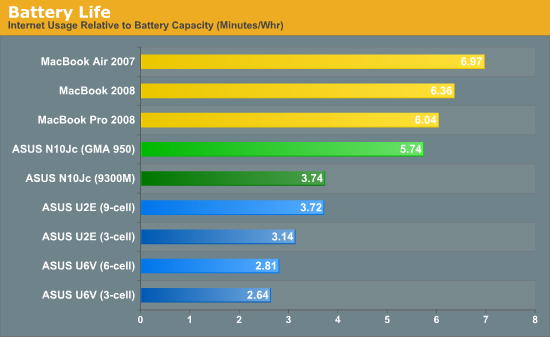
We don't have results for all of the test systems under each test scenario, but probably the most interesting performance metric is going to be battery life while surfing the web. There we see that the N10JC just manages to edge out the new Apple MacBooks, nearly matching the U2E with a 9-cell battery. That's great for Windows performance, but unfortunately you need to keep two things in mind. First, the Apple MacBook line is still offering better battery life relative to battery capacity. Second, the same MacBooks all offer quite a bit more performance -- in most cases they're at least twice as fast as the N10JC. That's the bad news; the good news? The ASUS N10JC still costs half as much as the cheapest MacBook, which definitely works in its favor.
One other item we have to address is the video decoding performance. x264 playback totally failed to stay in sync when we tried to watch a movie using just the CPU. We still ran the 720p battery tests, but if you want to watch such content you will need to enable the 9300M. We used Media Player Classic Home Theater (WMP-HC), following this guide, and didn't experience any problems. CPU usage dropped from 80%+ with noticeably delayed video to under 20% with no discernible synchronization problems.
We should also mention that system temperatures and noise levels on the N10JC are great. Temperatures never got above 32°C during testing, and the fan rarely kicked up to higher RPMs except during extended stress testing or gaming. We could not measure noise levels above the threshold of our SPL meter (30 dB).










45 Comments
View All Comments
DILLIGAFF - Wednesday, December 24, 2008 - link
Thanks for listening :)i checked the download page and the utility is called power4gears hybrid under utilities for n10jc. in the utility you go to performance and in lower left there is a turbo dropdown. change it and save. i used cpuz to verify clocks
supposedly there is a way to wire it to the power profile button but i gave the laptop to my girl before i could get it all done
DILLIGAFF - Wednesday, December 24, 2008 - link
looks like vista only...my bad...ouchpattycake0147 - Wednesday, December 24, 2008 - link
The text of the article on page makes mention of a Western Digital drive while the specs and picture show a Seagate drive. You might want to change the WD to Seagate.Khato - Wednesday, December 24, 2008 - link
Just wondering why the article is stating that the 945GME chipset is used, contrary to Asus' spec page which has it using the 945GSE? Sure it's not all that much of a difference, just 1 watt on the TDP and a smaller package.Still find it annoying how many manufacturers are unwilling to touch the US15W. I'm guessing the combination of it only supporting 1GB of memory (really don't understand why that design decision was made) along with it costing more is the reason...
JarredWalton - Wednesday, December 24, 2008 - link
Fixed... I'm guessing the 1GB limitation is exactly why companies stay away from the US15W. Like you, I'm a little surprised that Intel didn't support 2GB with the chipset; I mean, how much of a change would that be? Still, the next generation Moorestown platform should hopefully correct the power requirements of the chipset.Khato - Thursday, December 25, 2008 - link
Well, the reason for limiting the configuration to 1GB was almost certainly to save a pin. Support for 2GB would require one more addressing pin, which in a low cost product is significant. It also may well have been somewhat a marketing decision - it's a constraint that can keep the platform from growing upwards too far performance wise.Hopefully Moorestown allows for 2GB of memory, but it may very well stay at 1GB. After all, that's still more than enough for the intended market, and I believe you'll be stuck with whatever Intel provides for the chipset.
iFX - Wednesday, December 24, 2008 - link
... but smaller companies might.Large corporate IT departments have their own "procurement" sub-groups which handle IT equipment purchasing. These groups generally buy in bulk, say 100-200 notebooks at a time from companies they have service contracts with like HP and Dell. They buy for considerably less than what consumers pay in the retail channel. For $700 they can buy a considerably better equipped notebook. These groups generally make purchases with a "one size fits all" attitude, therefor, netbooks are out as a software developer won't want to be doing all his work on a tiny netbook - the same goes for an accountant or an attorney.
Small companies like AnandTech for instance might buy these new netbooks because they don't have sophisticated infrastructures, large numbers of employees, huge service contracts and IT purchasing can be done on a more personal level - many times with the actual employee making the purchase. Equipment, models, brands, etc are not uniform in small companies.
iFX - Wednesday, December 24, 2008 - link
And on top of all that... keep in mind that 99% of large companies operate in a Microsoft Windows domain environment and XP Home is not able to attach to a domain natively.Penti - Wednesday, December 24, 2008 - link
Ergo my first comment on this article.There's a 800 dollar business version though not perfect because too low res for business and lack of 3G modem option, with VB, 2GB of RAM and a 320GB drive that I would have rather saw reviewed instead of the consumer version.
So not even the N10J-A2 fit the bill as a ultra-portable business notebook. But I would have rather seen it's week spots instead of the consumer version. As said not perfect for business but it at least is better then this and has a chance of being useful.
JarredWalton - Wednesday, December 24, 2008 - link
All of what I had to say about the N10JC-A1 applies to the N10J-A2, but with a change in RAM, HDD, and OS. As for large corporations, I don't think they get as much of a break on hardware as you assume. I worked for Target Corp. and they used Dell hardware, but I'm pretty sure they were spending *more* on the laptops/PCs because they wanted a 4-year onsite, next day service warranty. Of course, you're overlooking the fact that big corporations also just wipe the HDDs and install their volume license copy and standard build of Windows XP Pro -- I did that for three years at Target, at least.